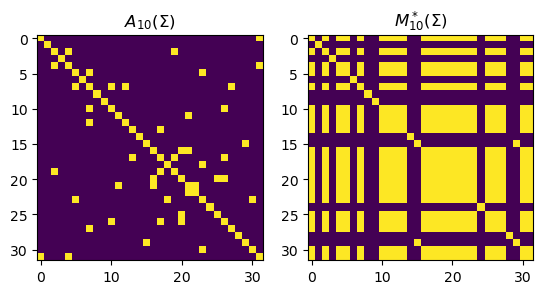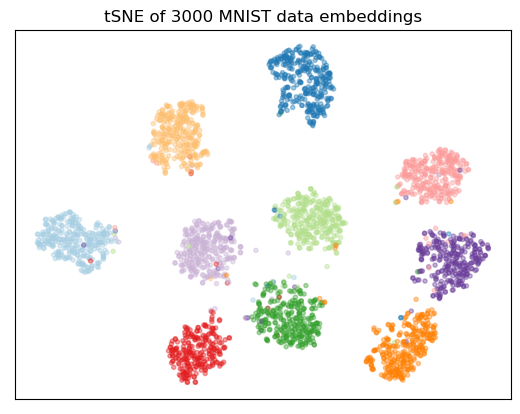Training a CNN on MNIST with the Partial Fenchel-Young Loss
In this example we will train a simple Conv Net on MNIST data using jaxclust. We will use:
jaxclust: for differentiable clustering methods.flax: for our neural network class and train state.optax: for the optimizer to train our network.tensorflow-datasets: to access MNIST.
[1]:
import sys
sys.path.append('../..')
import jax
import numpy as np
import jax.numpy as jnp
from typing import Callable, Tuple, Any
import tensorflow as tf
import jaxclust
import optax
import flax.linen as nn
from flax import core, struct
from flax.training import train_state
import optax
from functools import partial
import tqdm
import matplotlib.cm as cm
import matplotlib.pyplot as plt
np.random.seed(0)
# Ensure TF does not see GPU and grab all GPU memory.
tf.config.set_visible_devices([], device_type='GPU')
Data loader and Model
Using
tensorflow-datasetswe can load the train split of MNIST.The function
process_nist_batchreshapes the data to the shape required for LeNET5, as well as renormalizing the data and creating a one-hot representation of the labels.The function
next_traintakes an iterator and returns a batch \((x, y)\), and the iterator (and creates a new iterator if we reach the end of the current one).
[2]:
import tensorflow_datasets as tfds
DSHAPE = (28, 28, 1) # shape of an image for CNN
BS = 32
DATA_DIR = '/tmp/tfds'
@jax.jit
def process_nist_batch(x, y):
x = x.reshape((len(x), ) + DSHAPE)
x = x / 255.
yhot = jax.nn.one_hot(y, 10)
return x, yhot
DS_TRAIN = tfds.load(name='mnist', batch_size=-1, data_dir=DATA_DIR, split='train', as_supervised=True)
DS_TRAIN = tf.data.Dataset.from_tensor_slices(DS_TRAIN).shuffle(buffer_size=60000, seed=0, reshuffle_each_iteration=True)
DS_TRAIN = DS_TRAIN.batch(batch_size=BS)
train_iterator = iter(tfds.as_numpy(DS_TRAIN))
def next_train(train_iterator):
try:
(x, y)= next(train_iterator)
if x.shape[0] != BS:
train_iterator = iter(tfds.as_numpy(DS_TRAIN))
(x, y) = next(train_iterator)
except StopIteration:
train_iterator = iter(tfds.as_numpy(DS_TRAIN))
(x, y)= next(train_iterator)
x, y = process_nist_batch(x, y)
return (x, y), train_iterator
2023-11-23 19:05:58.077676: W tensorflow/core/platform/cloud/google_auth_provider.cc:184] All attempts to get a Google authentication bearer token failed, returning an empty token. Retrieving token from files failed with "NOT_FOUND: Could not locate the credentials file.". Retrieving token from GCE failed with "FAILED_PRECONDITION: Error executing an HTTP request: libcurl code 6 meaning 'Couldn't resolve host name', error details: Could not resolve host: metadata".
Downloading and preparing dataset 11.06 MiB (download: 11.06 MiB, generated: 21.00 MiB, total: 32.06 MiB) to /tmp/tfds/mnist/3.0.1...
Dataset mnist downloaded and prepared to /tmp/tfds/mnist/3.0.1. Subsequent calls will reuse this data.
2023-11-23 19:06:01.055647: W tensorflow/core/platform/profile_utils/cpu_utils.cc:128] Failed to get CPU frequency: 0 Hz
We begin by creating a simple CNN model in flax (this will be the model used to create our embeddings):
[3]:
class CNN(nn.Module):
"""A simple CNN model."""
dense1: int = 256 # size of dense layer
dense2 : int = 256 # size of output layer
@nn.compact
def __call__(self, x, training=True):
x = nn.Conv(features=32, kernel_size=(3, 3))(x)
x = nn.relu(x)
x = nn.avg_pool(x, window_shape=(2, 2), strides=(2, 2))
x = nn.Conv(features=64, kernel_size=(3, 3))(x)
x = nn.relu(x)
x = nn.avg_pool(x, window_shape=(2, 2), strides=(2, 2))
x = x.reshape((x.shape[0], -1)) # flatten
x = nn.Dense(features=self.dense1)(x)
x = nn.relu(x)
x = nn.Dense(features=self.dense2)(x)
return x
Implementing Differentiable Clustering with JAXClust
Firstly we need to define a similarity measure. There are many choices one could take, but for now lets keep it simple and use the negative Euclidean square distance:
To calculate \(\Sigma\) we will write the function pairwise_square_distance using jax:
[4]:
def pairwise_square_distance(X):
"""
euclidean pairwise square distance between data points
"""
n = X.shape[0]
G = jnp.dot(X, X.T)
g = jnp.diag(G).reshape(n, 1)
o = jnp.ones_like(g)
return jnp.dot(g, o.T) + jnp.dot(o, g.T) - 2 * G
Given a similarity matrix \(\Sigma\) and a number of connected components \(k\), we recall the maximum weight k-connected-component forest problem:
where \(A_k^*(\Sigma)\) is the adjacency matrix for the maximum weight k-connected-component forest, and \(\mathcal{C}_k\) is the set of adjacency matrices which correspond to k-connected-component forests.
The maxmium weight k-connected-component forest will have weight:
To obtain a solver for this we can use jaxclust.solvers:
[5]:
# flp = forest linear program
solver = jaxclust.solvers.get_flp_solver(constrained=False, use_prims=True)
Since constrained = False, the function solver will take in two arguments Sigma and ncc (the number of connected components), and returns \(A^*(\Sigma)\) and \(M^*(\Sigma)\). Recall that \(M_k^*(\Sigma)_{ij} = 1\) if points \(i\) and \(j\) are in the same connected component / cluster otherwise \(0\). Let’s try it out on some randomly generated data:
[6]:
X = np.random.randn(BS, 3) # sample a batch of 3D data
S = - pairwise_square_distance(X) # calculate Sigma
A, M = solver(S, 10) # call the solver
fig, axs = plt.subplots(1, 2)
axs[0].imshow(A)
axs[1].imshow(M)
axs[0].set_title(r'$A_{10}(\Sigma)$')
axs[1].set_title(r'$M_{10}^*(\Sigma)$')
[6]:
Text(0.5, 1.0, '$M_{10}^*(\\Sigma)$')

Similar using jaxclust.solvers we can call the function get_flp_solver but with constrained=True to obtain a solver that takes in partial cluster coincidence information.
In the paper \(M_\Omega\) takes values in \(\{0, 1, *\}\).
For clarity, jaxclust takes the constraints in the form of a matrix \(C\) where:
\(C_{ij}=1\) implies a must-link constraint.
\(C_{ij}=-1\) implies a must-not-link constraint.
\(C_{ij}=0\) implies no constraint.
(Non-important note: if denote \(*=0.5\), then \(C = 2 * M_\Omega - 1\)).
Once again we can call get_flp_solver to obtain a solver, but this time using the constrained=True kwarg:
[7]:
csolver = jaxclust.solvers.get_flp_solver(constrained=True, use_prims=True)
Now we have a unconstrained solver solver, and a constrained solver csolver, we can use the jaxclust.perturbations module to create their smooth proxies in order to obtain gradients for training.
The perturbed proxies are defined as:
We can obtain a solver that returns \((A^*_{k,\epsilon} , F^*_{k, \epsilon}, M^*_{k, \epsilon})\) by using the function make_pert_flp_solver found in the jaxclust.perturbations module, for both constrained and unconstrained solvers:
[8]:
NUM_SAMPLES = 100
SIGMA = 0.1
pert_solver = jaxclust.perturbations.make_pert_flp_solver(solver,
constrained=False,
num_samples=NUM_SAMPLES)
pert_csolver = jaxclust.perturbations.make_pert_flp_solver(csolver,
constrained=True,
num_samples=NUM_SAMPLES)
We can now implement the whole differentiable clustering pipeline as a flax.linen.Module.
We define a dataclass called DC (differentiable clustering), which takes in:
backbone: This will be the model used to produce the embeddings, say for example our CNN we previously define.pert_solver: The unconstrained perturbed solver.pert_csolver: The constrained perturbed solver.
The forward pass calculates the Partial Fenchel-Young loss:
\(\ell(\Sigma, M_\Omega) = F_{k,\epsilon}^*(\Sigma) - F_{k,\epsilon}^*(\Sigma, M_\Omega)\)
whose gradient will be \(\nabla_\Sigma \ell = A_{k, \epsilon}^*(\Sigma) - A_{k, \epsilon}^*(\Sigma, M_\Omega)\):
[9]:
class DC(nn.Module):
'''
supervised differentiable clustering
'''
backbone : nn.Module # model backbone used to create embeddings
pert_solver : Callable # perturbed clustering
pert_csolver : Callable # perturbed constrained clustering
# call is equivalent to embedding the data
@nn.compact
def __call__(self, *args, **kwargs):
return self.backbone(*args, **kwargs)
def similarity(self, Z):
S = -pairwise_square_distance(Z)
# standardizing reduces dependence of sigma on x
S = (S - S.mean()) / S.std()
return S
def forward(self, x, yhot, ncc, sigma, key, training=True):
Z = self.__call__(x, training=training)
S = self.similarity(Z)
M_target = yhot @ yhot.T
C = 2 * M_target - 1
Ak, Fk, Mk = self.pert_solver(S, ncc, sigma, key)
Akc, Fkc, Mkc = self.pert_csolver(S, ncc, C, sigma, key)
partial_fy_loss = Fk - Fkc
return partial_fy_loss
In line with flax, we will define a train state which encapsulates all parameters (model and optimizer) and methods required for training / evaluation:
[10]:
class DCTrainState(struct.PyTreeNode):
step: int
apply_fn: Callable = struct.field(pytree_node=False)
forward_fn: Callable = struct.field(pytree_node=False)
params: core.FrozenDict[str, Any] = struct.field(pytree_node=True)
tx: optax.GradientTransformation = struct.field(pytree_node=False)
opt_state: optax.OptState = struct.field(pytree_node=True)
def apply_gradients(self, *, grads, **kwargs):
updates, new_opt_state = self.tx.update(
grads, self.opt_state, self.params)
new_params = optax.apply_updates(self.params, updates)
return self.replace(
step=self.step + 1,
params=new_params,
opt_state=new_opt_state,
**kwargs,
)
@classmethod
def create(cls, *, apply_fn, forward_fn, params, tx, **kwargs):
opt_state = tx.init(params)
return cls(
step=0,
apply_fn=apply_fn,
forward_fn=partial(apply_fn, method=forward_fn),
params=params,
tx=tx,
opt_state=opt_state,
**kwargs,
)
Let us instantiate our model and optimizer:
[11]:
optimizer = optax.adamw(3e-4, weight_decay=1e-4)
model = DC(
CNN(),
pert_solver=pert_solver,
pert_csolver=pert_csolver)
[12]:
dummy_x = jnp.ones((BS, ) + (DSHAPE))
params = model.init({'params' : jax.random.PRNGKey(0)}, dummy_x, training=True)['params']
[13]:
from clu import parameter_overview
print(parameter_overview.get_parameter_overview(params))
+-------------------------+----------------+---------+-----------+--------+
| Name | Shape | Size | Mean | Std |
+-------------------------+----------------+---------+-----------+--------+
| backbone/Conv_0/bias | (32,) | 32 | 0.0 | 0.0 |
| backbone/Conv_0/kernel | (3, 3, 1, 32) | 288 | 0.0223 | 0.342 |
| backbone/Conv_1/bias | (64,) | 64 | 0.0 | 0.0 |
| backbone/Conv_1/kernel | (3, 3, 32, 64) | 18,432 | -0.000226 | 0.0587 |
| backbone/Dense_0/bias | (256,) | 256 | 0.0 | 0.0 |
| backbone/Dense_0/kernel | (3136, 256) | 802,816 | -1.17e-05 | 0.0178 |
| backbone/Dense_1/bias | (256,) | 256 | 0.0 | 0.0 |
| backbone/Dense_1/kernel | (256, 256) | 65,536 | -9.22e-05 | 0.0625 |
+-------------------------+----------------+---------+-----------+--------+
Total: 887,680
[14]:
state = DCTrainState.create(
apply_fn=model.apply,
forward_fn=model.forward,
params = params,
tx = optimizer
)
We can now make a function that performs a single training step given a batch of data. This is jax.jit compatible.
[15]:
@jax.jit
def train_step_fn(state, X, Yhot, ncc, sigma, rngs):
def forward(params, X, Yhot, ncc, sigma, rngs):
return state.forward_fn({'params' : params}, X, Yhot, ncc, sigma, rngs['noise'], True, rngs=rngs)
loss, grads = jax.value_and_grad(forward)(state.params, X, Yhot, ncc, sigma, rngs)
state = state.apply_gradients(grads=grads)
return state, loss, grads
We can use the above function to perform a training loop in just a few lines of code:
[16]:
NSTEPS = 300
rngs = {'noise' : jax.random.PRNGKey(0)}
SIGMA = 0.1
losses = []
for i in tqdm.tqdm(range(NSTEPS)):
rngs = {k : jax.random.fold_in(v, i) for (k, v) in rngs.items()}
(X, Yhot), train_iterator = next_train(train_iterator)
state, pl, grads = train_step_fn(state, X, Yhot, 10, SIGMA, rngs)
losses.append(pl.item())
0%| | 0/300 [00:00<?, ?it/s]100%|██████████| 300/300 [00:49<00:00, 6.02it/s]
Plotting the partial Fenchel-Young loss throughout training with and without smoothing:
[17]:
import matplotlib.pyplot as plt
def moving_average(x, w):
return np.convolve(x, np.ones(w), 'valid') / w
plt.plot(moving_average(losses, 10), color='g', label='moving average')
plt.plot(losses, color='b', alpha=0.2, label='raw')
plt.xlabel('step')
plt.ylabel('Partial FY Loss')
[17]:
Text(0, 0.5, 'Partial FY Loss')

Perform a tSNE visualization of the model embeddings for some of the dataset:
[18]:
NTSNE = 3000
X, Y = tfds.load(name='mnist', batch_size=-1, data_dir=DATA_DIR, split='train', as_supervised=True)
X = np.array(X)
Y = np.array(Y)
X = X[:NTSNE].reshape(-1, 28, 28, 1) / 255.0
Y = Y[:NTSNE].astype('int')
[19]:
from sklearn.manifold import TSNE
V = state.apply_fn({'params' : state.params}, X)
tsne = TSNE(n_components=2).fit_transform(V)
/Users/lawrencestewart/miniconda3/envs/m1/lib/python3.9/site-packages/sklearn/manifold/_t_sne.py:795: FutureWarning: The default initialization in TSNE will change from 'random' to 'pca' in 1.2.
warnings.warn(
/Users/lawrencestewart/miniconda3/envs/m1/lib/python3.9/site-packages/sklearn/manifold/_t_sne.py:805: FutureWarning: The default learning rate in TSNE will change from 200.0 to 'auto' in 1.2.
warnings.warn(
[20]:
TSNE_COLORS = [
'#a6cee3','#1f78b4','#b2df8a','#33a02c','#fb9a99','#e31a1c','#fdbf6f',
'#ff7f00','#cab2d6','#6a3d9a',
]
color_map = np.array([TSNE_COLORS[i] for i in range(10)])
plt.scatter(tsne[:, 0], tsne[:, 1], color=color_map[Y], marker='.', alpha=0.4)
plt.title(f'tSNE of {NTSNE} MNIST data embeddings')
plt.xticks([])
plt.yticks([])
[20]:
([], [])

The differentiable clustering methodology comes from the following paper:
[Stewart et al. 2023] - Differentiable Clustering with Perturbed Random Forests, Advances in Neural Information Processing Systems 2023.